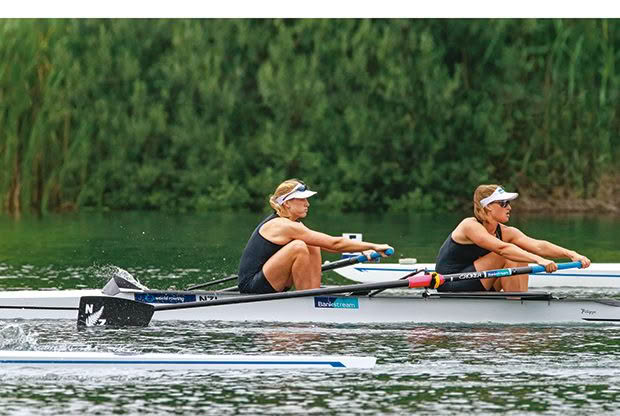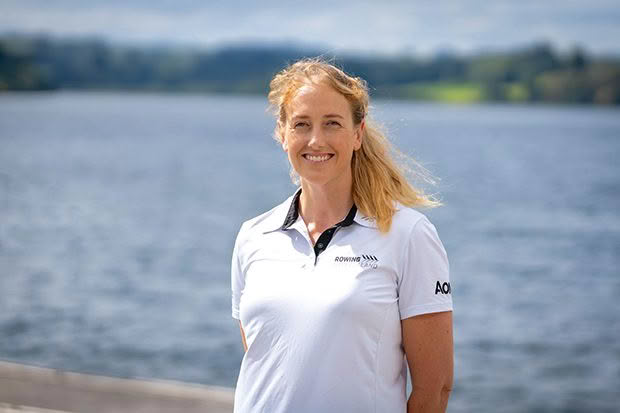Strength is the key to this woman’s success in rowing (both in and out of the water)

Louise Storey’s role at Rowing New Zealand is to help the country’s rowing elite cope with the pressure-cooker environment of high-performance sport.
Words: Heather Kidd
High-performance athletes aren’t born high performers. Some are blessed from the get-go due to their physical, physiological and mental makeup. But anyone who becomes a high-performance athlete earns that status because they’ve worked hard — harder than most could conceive — to be among the top echelon in their sport.
How athletes train has changed; technology, the game-changer. Training sessions have become more data-driven, and coaches and support staff now access information about every athlete. There’s nowhere to hide. But one area remains difficult to quantify. It is as complex as it is individual, and until very recently, remained in the shadows: athlete wellbeing.
Louise Storey, 37, recently appointed athlete wellbeing lead for Rowing New Zealand, has been at the sport’s coalface. The Dunedin-born former rower, now based in Cambridge, competed at the highest level — world championships and the Olympics. She has a Bachelor of Physical Education and post-grad diplomas in rehabilitation and sports medicine. Before she joined Rowing NZ, she spent five years with New Zealand Football as a player welfare officer.
“My role at Rowing NZ is a new one within the realms of high performance,” she says. “While initially it’s been about reacting to the immediate needs of the athletes, it’s also about looking at the organisation and making plans for the future.”
Aligning with the Te Whare Tapa Whā model, which incorporates the four dimensions of wellbeing — physical health, mind, family and spiritual — provides Louise with a holistic template, referencing what makes an athlete who they are and how they can become the best version of themselves.
As she points out, a high-performance environment is highly challenging. “It’s super tough on your wellbeing. You’re not going to have things being a hundred per cent awesome a hundred per cent of the time.”
She stresses the importance of processes so athletes understand and trust selection guidelines, that the lines of communication between coaches and rowers are open, and the power imbalance between management, coaches and athletes is addressed.
“We’re getting to a place where trust is being built. We’re encouraging athletes to ask questions about the programme and the organisation. If they do that, we’re in a better position to help them as athletes.
“We’re there to support the athletes, to help them to reach their goals — that’s how it should be, not the other way around. We want to limit the background noise an athlete is exposed to — issues such as sport’s politics, communication and trust and strategy concerns — so they can focus on what they need to do. And that is to row fast.”
Despite the groundswell of opinion advocating the importance of wellbeing, especially regarding New Zealand’s high-performance athletes, highlighted by the suicide of New Zealand cyclist Olivia Podmore in 2021, Louise says there are members of the public — and even from within the sporting context — who are reluctant to embrace the introduction of wellbeing to the high-performance programme.
“There’s a real fear that athlete wellbeing will take away from the performance side of things. My message is that there’s a large amount of overlap between wellbeing and performance, and when an athlete is in a supportive environment, it will help improve their performance. We’re on the same page; we’re not taking away from one area or other.
“Athletes know what they must do to perform on the world stage. They always have that in their mind. They know it’s not going to be easy. Part of my job is to let them keep ticking away to get to where they need to be. Wellbeing and performance go hand in hand.”
Another wellbeing initiative includes High Performance Sport New Zealand providing two performance life advisors to help the high-performance squad consider what life outside of rowing might look like, short and long-term. They work with the athletes one-to-one, helping some to apply for prime minister scholarships, which give them $10,000 towards continuing their education.
“We want athletes to have something outside of rowing. For some, it might be studying, something to work towards because your life after rowing is long. For others, it’s about taking up a hobby. Also, everyone has times when their rowing isn’t going well, and it’s important to have something in your life that can go well.”
What is certain is that by the time a rower is part of the high-performance set-up, there’s no doubting their physical skillset. Another trait that will help them perform to the best of their ability is resilience.
“You can’t simply attend a workshop and be given tools to become resilient,” says Louise. “It’s a skill that needs to be practised, and in a practical sense, you need to experience the struggle to develop that skill — and it is a skill. Those periods where you’re not going so well are necessary. They’re part of being an athlete. Any time you fall short of your expectations is a moment when you learn, where you develop the resilience that will help you to be the best athlete you can be.
“However, there’s a limit to how much one person can take. In some ways, telling athletes they need to be more resilient is a bit like putting the onus on them when, in fact, the responsibility
lies with the organisational processes and procedures.
“We have a fantastic set-up at Karapiro — the building, support staff, the intelligence — all the systems are in place. Because of that, we know with some confidence that if athletes can hit certain markers within our programme, they will be okay on the international stage.”

DETERMINED TO SUCCEED
Louise took up rowing at 13 when living in Wellington, where her brother Mike belonged to the Star Boating Club. She continued with the sport during her university years in Dunedin, getting serious about the sport in the third year of her degree. Her initial goal was to get an RPC (regional performance centre) trial, but her ambitions were knocked back when she was told she was too small. Instead of giving up, she decided to keep rowing because she enjoyed it, and eventually, her speed in the boat meant selectors couldn’t ignore her. Louise rowed in the New Zealand senior women’s quadruple scull 2009-2012 (the crew won bronze at the 2011 world champs) and was a member of the women’s eight in 2010. In 2014, she was paired with Rebecca Scown. The two succeeded nationally and internationally, finishing third at the 2014 world champs.
NEEDING RESILIENCE
Being resilient has helped Louise to cope with two of the most challenging times of her life. At the 2012 Olympics, she was one of the women’s quadruple scull crew that made it into the repechage. During the race, Louise’s oar broke, a freak occurrence which dashed any hopes of the crew making the final.
On a personal level, two years ago, Ava (4), the elder daughter of Louise and her husband John Storey, also a former Olympic and world championship rower, was diagnosed with 1p36 deletion syndrome, a rare chromosome disorder. Never has Louise needed her resilience more.
“Unlike trisomy 21 (Down syndrome), where you have an entire extra chromosome, those with 1p36 deletion syndrome are missing a portion of the top of their first chromosome, a crucial area for development. The syndrome presents itself in various ways — from those with extremely high needs with serious health concerns to a few who have, with support, gone to college,” says Louise.
“Ava can walk but has poor balance. She is non-verbal but communicates with her own version of sign language. She has sensory issues with noise, particularly in the car, and bites herself when frustrated. Despite her difficulties communicating, she understands relatively well and should never be underestimated.
“What we know from our personal experience as athletes is to appreciate the small gains, and that is how we approach life day to day with her.”
The couple also has another daughter, Briar, who is 18 months old.
Love this story? Subscribe now!
 This article first appeared in NZ Life & Leisure Magazine.
This article first appeared in NZ Life & Leisure Magazine.
